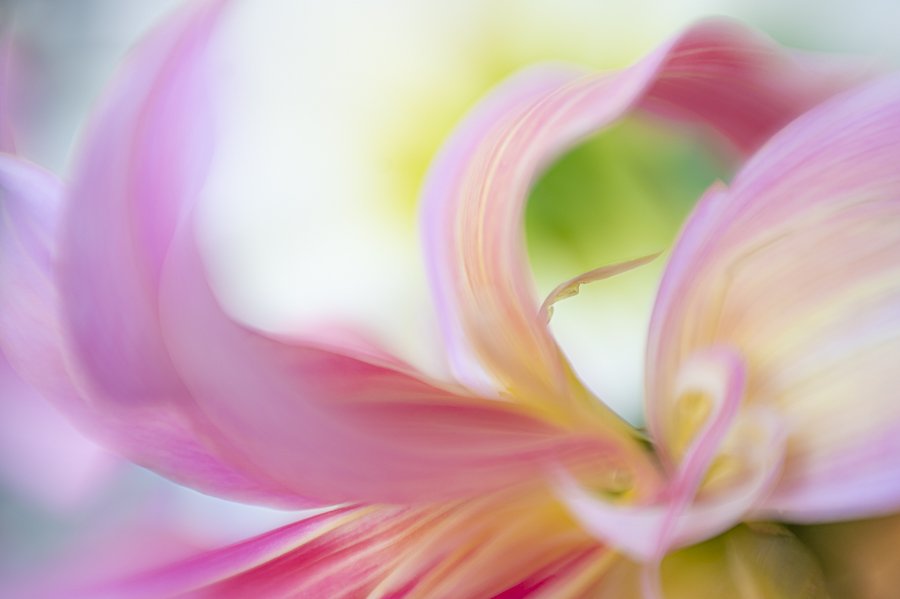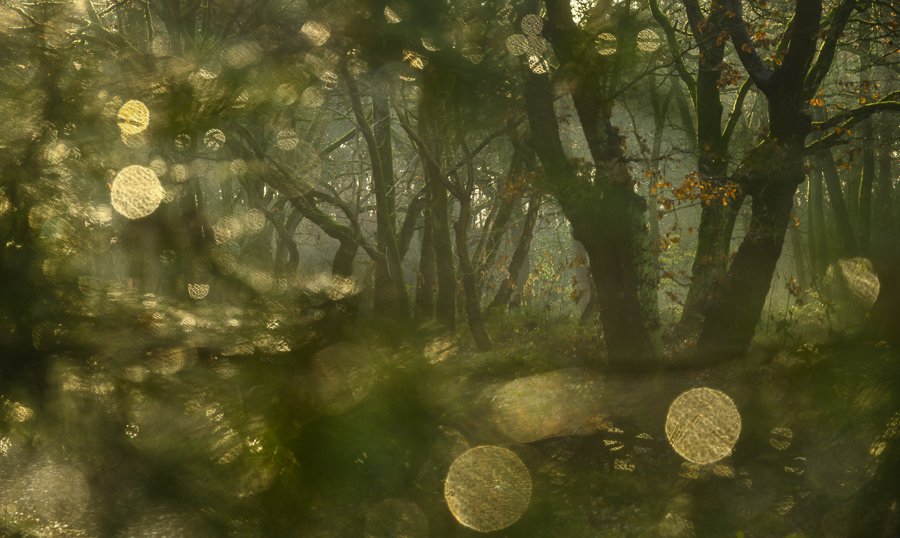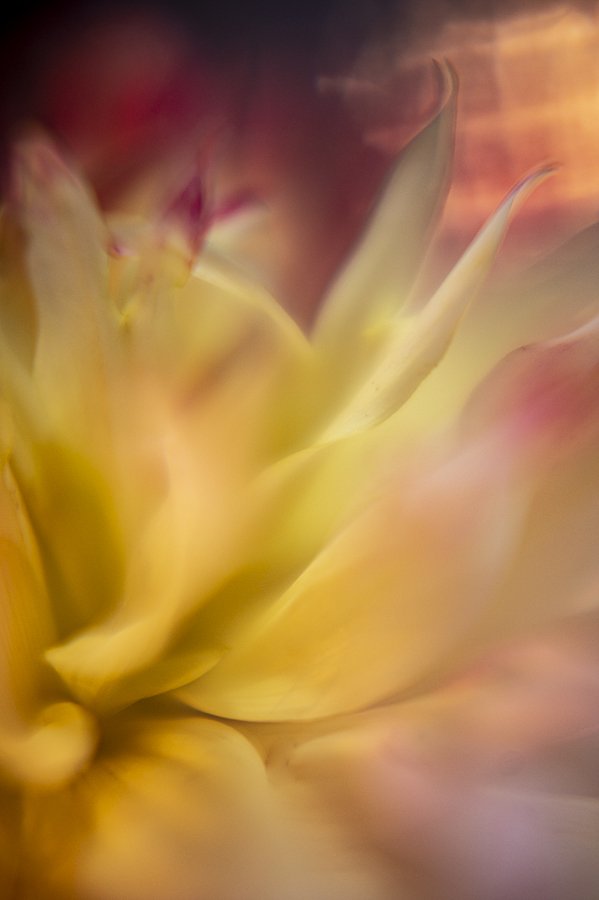(Click here for the original article in Dutch.)
Interview with Andrea Gulickx by Ruud van der Bliek
For Nature First NL/BE I sat down with the well-known Dutch photographer and workshop leader Andrea Gulickx to discuss how she approaches nature during her photography and workshops.

Andrea lives with her husband in a lovely house with an abundant flower garden in the village of IJzendoorn in the Betuwe. The village is protected by a high dike, right on the river Waal. The river, with its floodplains and woodlands, is an important source of inspiration for her photography. So important that she devoted her first published photo book ‘De Waal Bewogen‘ to it. This book marks the beginning of her current style of photography, in which she makes extensive use of ICM (intentional camera movement, a way of painting with light).

Despite the fact that she uses landscapes and nature as subjects for her photos, she emphatically does not call herself a landscape or nature photographer. Landscapes are there to paint with, as are mushrooms and her favourite “wild” flowers, the bluebell and the wood anemone. In the Netherlands, these two flowers are almost exclusively found on estates where they were once planted and naturalized. You can also find it in landscaped flower gardens. She hardly visits vulnerable biotopes such as flower meadows and damp areas with dragonflies and butterflies, and taking a workshop group out there is out of the question.
On the one hand because she has insufficient knowledge of these areas and how to move around in them without causing damage and on the other hand because she doesn’t feel like going to much effort for a specific location or subject. From a photographic point of view, special species do not interest her at all. Her photos mainly contain light, shapes and emotion and the subjects are merely extras.
Even when she does not use the ICM technique, she is always looking for the light and special angles. No registration photos from her hand, but carefully made atmospheric photos with soft shapes and pastel shades. The process of taking and editing photos is much more fun and interesting for her than the subject to be photographed itself.
She often uses Laowa macro lenses, which have a 2x magnification factor and with which she likes to create abstract images. She is also a huge fan of Lensbaby’s creative lenses. She is ambassador in the Netherlands for both brands.

During her workshops, she introduces her participants to her characteristic way of photographing and keeps no secrets. She shares her method and techniques openly and honestly, so that everyone knows how to make a characteristic ‘Andrea photo’. The workshops are given on country estates and in landscaped flower gardens. She only goes into the forest with the students for mushrooms. In advance she asks the participants to pay attention to the vulnerability of the environment where they are. That is not so difficult with flower gardens, because you can’t get off the paths there anyway. She’s very aware of the fragility of the specific ‘stinsen plants’ on the estates and makes sure that no damage occurs. Among other things, she asks for attention to the careful placement of photo bags, to photograph as much as possible from the paths and to not trample anything. As protection against the often wet ground you lie on, she advises the students to use rain pants instead of a plastic garbage bag. In rain pants, your print on the ground is much smaller and you can see where you move much better than lying on a large plastic bag, which can also be forgotten or blown away. During the workshops she is always attentive to the unconscious or careless behaviour of her students and she makes sure not to leave anything behind. “One of the reasons I have small workshop groups is the vulnerability of nature,” says Andrea.

As we go through the Nature First Principles, she immediately says that, in hindsight, she regrets sharing the location Landgoed Amelisweerd near Utrecht on social media. Once she started photographing wood anemones there, a plant species that, partly because of her photos, is now very much in the spotlight among macro photographers. By sharing her photos and mentioning the location, the pressure on this estate, but also on other estates where wood anemones and other stinsen plants grow, has increased explosively and unfortunately not everyone is equally careful with the plants and plant-beds. She hopes to never make that mistake again. ‘I am a person who likes to share knowledge, and for me that also included the locations. But I’ve become very careful with that now,” she says.
The fact is that a large number of estate managers are no longer happy with the increasing stream of photographers, too many of whom find the flowers next to the path less attractive than those a few meters further from the path.
Andrea is a photographer and therefore moves around in nature, not always aware of the impact her actions have on it. She’s not a do-gooder or nature activist. She does her best to behave as respectfully as possible to the best of her ability.

‘I am certainly not a saint,’ she says herself, ‘but I’m much more aware of everything now and I know a lot more than when I started. When you start photographing, you’re often not sufficiently aware of the fragility of nature. I remember very well that in my early days in the Belgian Hallerbos I myself thought that I was lying down very carefully and paying attention to everything in a gully with leaves, so that I would not destroy anything. The anemones were on a ledge and there was nothing to see around them. Jan Loos from Landschap VZW was walking around, and he very kindly asked me to go back to the trail. He then explained to me that under the leaves the hyacinths were already above the ground. If you step on those emerging hyacinths and damage them, they won’t come back. I was very happy with his explanation and especially the way he did it. Not only for myself, but also because I can pass this on to my workshop participants, so that they too understand why they should not go off the path. It made me much more aware of everything around me. I’m still grateful to him for this.”
“In the fall I really do my best to take everything into account. I always end up in the same piece of forest, know the trails well and use the same route so I know we’ll find subjects right next the path. In some beech avenues or in clearings where there are beech trees and where the ground is full of leaves, I do look for mushrooms. Always looking down carefully to avoid trampling anything. I have trained eyes in that regard, but of course you cannot see what is under the leaf. That remains a fact.”

“Last summer I was in the Azores and we went on a whaling expedition. Great, but I was quite shocked by the amount of plastic floating in the sea. On the way back to the harbour the excursion leaders fished as much plastic as possible from the sea and took it with them. I have to admit that I have become much more aware of litter now and take it with me when I find it in the woods.”
“I can get very annoyed by people who leave their mess here in the floodplains. On nice days you see groups of people picnicking here and when they are gone, the bags of trash are by the trees next to the water. Unbelievable! You brought it from home, why not take your waste back with you. How hard can it be?”
Years ago, my husband and I walked through the floodplains and found bulky waste at five locations. Computers, blue garbage bags, household goods, you name it. We reported this to the municipality, but they indicated that we had to report this to five different authorities, because the land was owned by five different owners. Yes, with so many barriers and discouragement, you’ll think carefully before reporting next time. Fortunately it was quickly removed. I’m sad to see it still happening today.”
“I can probably learn more about the fragility of nature myself. I try to do my part. If we all do a little we are well on the way.”
Andrea Gulickx, a special woman and photographer, with a very personal and inspiring style and a heart for nature.
